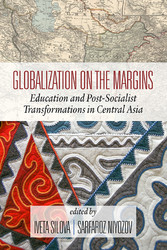Suchen und Finden
Service

Globalization on the Margins (2nd Edition) - Education and Post-Socialist Transformations in Central Asia
Iveta Silova, Sarfaroz Niyozov
Verlag IAP - Information Age Publishing, 2020
ISBN 9781641138840 , 603 Seiten
Format PDF
Kopierschutz DRM
Geräte
Mehr zum Inhalt

Globalization on the Margins (2nd Edition) - Education and Post-Socialist Transformations in Central Asia
Reflecting on almost three decades of postsocialist transformations, the second edition of Globalization on the Margins explores continuities and changes in Central Asian education development since the dissolution of the Soviet Union in 1991, with a particular focus on the developments that took place since the production of the first edition in 2011. Rather than viewing these transformations in isolation, the authors place their analyses within the global context by reflecting on the interaction between Soviet legacies and global education reform pressures in the Central Asian countries of Kazakhstan, Kyrgyzstan, Tajikistan, Turkmenistan, and Uzbekistan. This new edition, in addition to a revised introduction and a newly added conclusion, consists of four thematic sections, each reflecting a key theme in the educational life of the Central Asian states. These thematic sections, introduction and conclusion collectively update our understanding of the recent developments and challenges in education of the five Central Asian states. They, however, go beyond mere information update, so as to complicate, re-engage, re-form and re-define the margins, taking up ‘margins’ a conceptual, geographic, cultural, and geo-political construct. Notwithstanding the diversity of local and international authors, variety of theoretical perspectives, methodological approaches, and conceptual lenses, the essays reveal the complexity and uncertainty of the post-socialist education transformations. Instead of portraying the transition process as the influx of Western ideas into the region, Globalization on the Margins provides new lenses to critically example education as a contested field of diverse perspectives, competing forces, and multidirectional flow of ideas, concepts, and reforms in Central Asia.
ENDORSEMENTS:
Hindsight famously brings clarity. And, much of what happened after the fall of the Berlin Wall and the collapse of the Soviet Union has now been correctly deeded over to historians. Nonetheless, we ignore that history at our peril. The contributors to this volume show that carefully textured and historically attuned education research generates deep insights into ongoing transformations and the political, cultural, social and economic structures, relations, and practices that do the work of producing margins and centers in the first place.
Noah W. Sobe, Loyola University Chicago
Globalization on the margins and at the epicentre of the battles of the Great Powers. Two excellent educators, Sarfaroz Niyozov and Iveta Silova, compiled a timely and long-awaited scholarly work based on empirical research in societies, which had similar history close to three decades ago. All the contributors are prolific educators who know the education system from within and without, who either hailed from the region or have spent a considerable amount of time to know the systems well. The book contains remarkable stories of education through the ups and downs of historical evolution. It is a must-read primer for anyone interested in learning about high quality research in the field of education in Central Asia. It is a huge contribution to educational research with an impact on research and teaching for years to come.
Duishon Shamatov, Nazarbayev University, Kazakhstan
The challenge of moving Central Asia from the borders of the Soviet Empire to the world’s center is the focus of the discussions in ‘Globalization on the Margins.’ The transition to the Western models of education was happening in the context of major paradigm shift, which entire humanity was experiencing and which could be described as the arrival of the new post-industrial civilization. During this process, Central Asian countries have been pushed to the margins, because their contribution to the wealth of the new world know-how was much less pronounced than that of their Western neighbours. Therefore, investment into the research that contributes to local knowledge production seems a natural solution to the problem. All the contributors to this book have a vast experience in the region and many of their observations are thought provoking. This is a very insightful and much needed book.
Elena Lenskaya, Moscow School of Social and Economic Sciences, Russia
Shop

